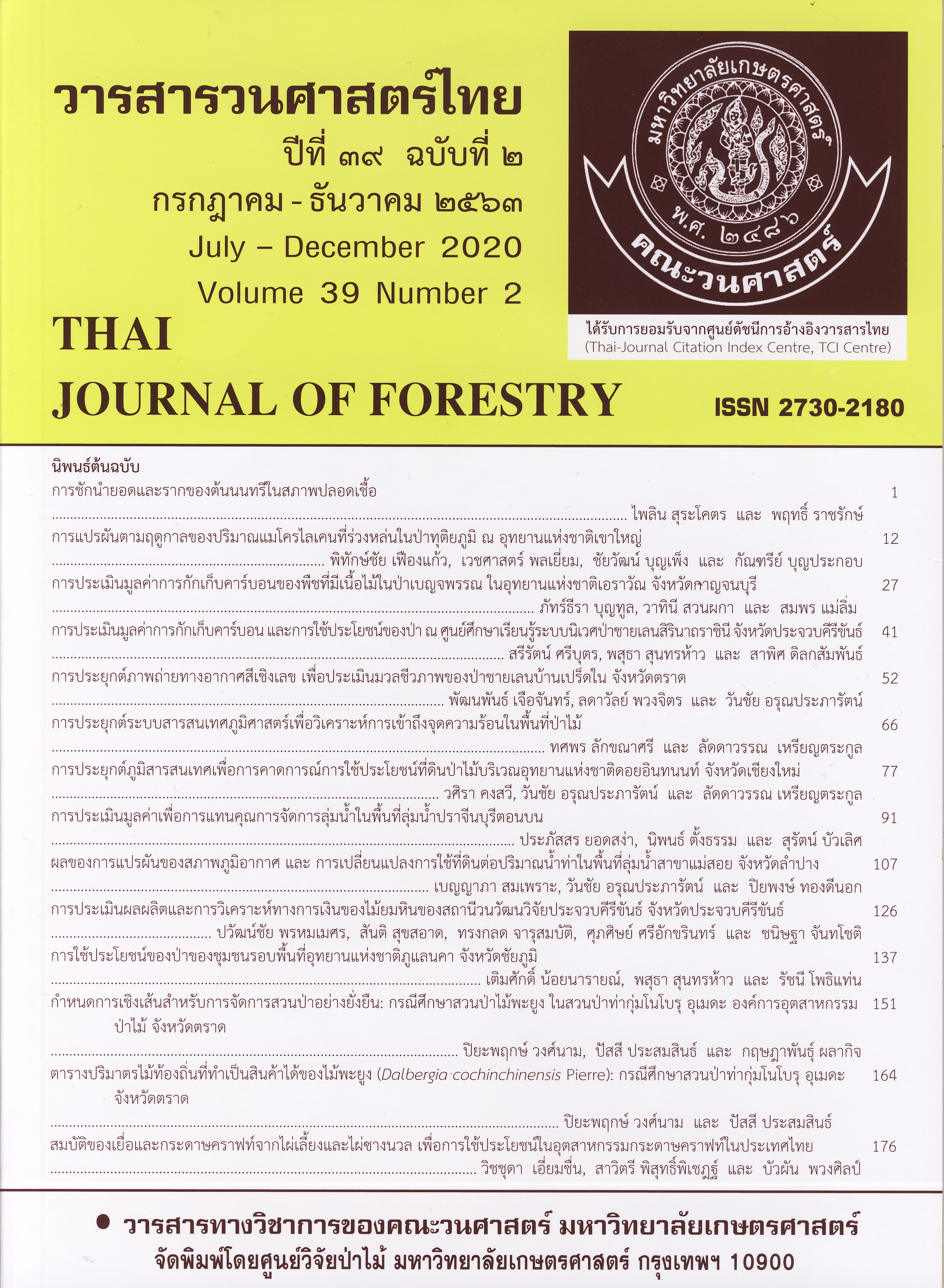ผลของการแปรผันของสภาพภูมิอากาศ และการเปลี่ยนแปลงการใช้ที่ดิน ต่อปริมาณนํ้าท่า ในพื้นที่ลุ่มนํ้าสาขาแม่สอย จังหวัดลำปาง
Main Article Content
บทคัดย่อ
การศึกษาของผลการแปรผันของสภาพภูมิอากาศและการเปลี่ยนแปลงการใช้ที่ดินต่อปริมาณนํ้าท่าดำเนินการในพื้นที่ลุ่มนํ้าสาขาแม่สอย จังหวัดลำปาง มีวัตถุประสงค์เพื่อวิเคราะห์ผลของการแปรผันของสภาพภูมิอากาศ และการเปลี่ยนแปลงการใช้ประโยชน์ที่ดินต่อปริมาณนํ้าท่า และประมาณค่าปริมาณนํ้าท่าจากแบบจำลอง SWAT รวมทั้งคาดการณ์ปริมาณน้ำท่าจากการเปลี่ยนแปลงสภาพภูมิอากาศภายใต้การเปลี่ยนแปลงภาวะก๊าซเรือนกระจกเข้มข้น (RCP 8.5) โดยอาศัยข้อมูลปัจจัยจำกัดทางอุทกวิทยา ได้แก่ ข้อมูลอุตุนิยมวิทยา (พ.ศ. 2550-2561) ข้อมูลการใช้ประโยชน์ที่ดินในปี พ.ศ. 2550 และปี พ.ศ. 2561 แบบจำลองความสูงเชิงเลข (Dem) และข้อมูลดิน
ผลการศึกษาพบว่า การคาดการณ์สภาพการใช้ประโยชน์ที่ดินในปี พ.ศ. 2572 มี พื้นที่ป่าไม้ลดลง พื้นที่เกษตรกรรมและพื้นที่แหล่งนํ้าเพิ่มขึ้นจากปี พ.ศ. 2561 คิดเป็นร้อยละ 6.30, 20.17 และ 32.85 ตามลำดับ ในขณะที่การใช้ประโยชน์ที่ดินอื่นๆ มีการเปลี่ยนแปลงเพิ่มขึ้นเพียงเล็กน้อย แบบจำลอง SWAT เป็นแบบจำลองกระบวนการทางอุทกวิทยาที่ถูกนำมาวิเคราะห์ปริมาณนํ้าท่าเฉลี่ยรายปีที่เกิดขึ้นจากสภาพภูมิอากาศ ซึ่งมีประสิทธิภาพระดับดีในการประมาณค่าปริมาณนํ้าท่า ผลการปรับเทียบแบบจำลองที่สถานีตรวจวัดนํ้าท่า W.17 มีค่า RMSE เท่ากับ 0.223-0.227 และค่า NSE เท่ากับ 0.893-0.897 โดยในปี พ.ศ. 2561 และ พ.ศ. 2572 จากการใช้ข้อมูลสภาพภูมิอากาศชุดเดียวกัน พบว่า มีปริมาณนํ้าท่าเฉลี่ยรายปีเท่ากับ 168.71 และ 170.87 ล้านลูกบาศก์เมตร คิดเป็นร้อยละ 24.66 และ 24.97 ของนํ้าฝนเฉลี่ยรายปี และมีสัดส่วนปริมาณนํ้าแล้งต่อปริมาณนํ้าหลากร้อยละ 36.15 และ 34.68 ตามลำดับ โดยมีศักยภาพการให้นํ้าท่าต่อหน่วยพื้นที่ประมาณ 0.23 ล้านลูกบาศก์เมตรต่อตารางกิโลเมตร มีปริมาณนํ้าท่าในปี พ.ศ. 2572 สูงกว่าปี พ.ศ. 2561 เล็กน้อย โดยเพิ่มขึ้นร้อยละ 1.26
การคาดการณ์ปริมาณนํ้าท่าจากการเปลี่ยนแปลงสภาพภูมิอากาศภายใต้ (RCP 8.5) กับการเปลี่ยนแปลงสภาพการใช้ประโยชน์ที่ดิน แสดงให้เห็นว่า ปริมาณนํ้าท่าเฉลี่ยรายปีในปี พ.ศ. 2593 และปี พ.ศ. 2613 มีค่าเท่ากับ 344.86 และ 372.65 ล้านลูกบาศก์เมตร คิดเป็นร้อยละ 39.12 และ 40.39 ของนํ้าฝนเฉลี่ยรายปี มีค่ามากกว่าปี พ.ศ. 2561 อยู่ร้อยละ 56.69 และ 59.92 ตามลำดับ และมีสัดส่วนปริมาณนํ้าแล้งต่อปริมาณนํ้าหลาก สูงขึ้นเท่ากับร้อยละ 50.81 และ 57.33 ตามลำดับ
Downloads
Article Details
ข้าพเจ้าและผู้เขียนร่วม (ถ้ามี) ขอรับรองว่า ต้นฉบับที่เสนอมานี้ยังไม่เคยได้รับการตีพิมพ์และไม่ได้อยู่ในระหว่างกระบวนการพิจารณาตีพิมพ์ลงในวารสารหรือสิ่งตีพิมพ์อื่นใด ข้าพเจ้าและผู้เขียนร่วม (ถ้ามี) ยอมรับหลักเกณฑ์และเงื่อนไขการพิจารณาต้นฉบับ ทั้งยินยอมให้กองบรรณาธิการมีสิทธิ์พิจารณาและตรวจแก้ต้นฉบับได้ตามที่เห็นสมควร พร้อมนี้ขอมอบลิขสิทธิ์ผลงานที่ได้รับการตีพิมพ์ให้แก่วารสารวนศาสตร์ คณะวนศาสตร์ มหาวิทยาลัยเกษตรศาสตร์ กรณีมีการฟ้องร้องเรื่องการละเมิดลิขสิทธิ์เกี่ยวกับภาพ กราฟ ข้อความส่วนใดส่วนหนึ่ง หรือ ข้อคิดเห็นที่ปรากฏในผลงาน ให้เป็นความรับผิดชอบของข้าพเจ้าและผู้เขียนร่วม (ถ้ามี) แต่เพียงฝ่ายเดียว และหากข้าพเจ้าและผู้เขียนร่วม (ถ้ามี) ประสงค์ถอนบทความในระหว่างกระบวนการพิจารณาของทางวารสาร ข้าพเจ้าและผู้เขียนร่วม (ถ้ามี) ยินดีรับผิดชอบค่าใช้จ่ายทั้งหมดที่เกิดขึ้นในกระบวนการพิจารณาบทความนั้น”
เอกสารอ้างอิง
Chaitham, W. 1987. Hydrology. 2nd Ed. Faculty of Engineering, Khon Kaen University, Khon Kaen. (in Thai)
Department of Water Resources. 2005. Study and Survey on Hydrological Station Design 25 Watershed of Thailand Project. Ministry of Natural Resources and Environment, Bangkok. (in Thai)
Department of Water Resources. 2006. Integrated Water Resources Management Plan Project in the Wang Watershed. Ministry of Natural Resources and Environment, Bangkok. (in Thai)
Department of Water Resources. 2018. Meteorology Data and Rain Station. Ministry of Natural Resources and Environment, Bangkok. (in Thai)
Institute of Water and Agricultural Resources Information (Public Organization). 2012. Data Collection and Analysis data Project of 25 Basin and Flood Drought Model, Wang River Basins. Ministry of Natural Resources and Environment, Bangkok. (in Thai)
Land Development Department. 2010. Soil Group Data. Soil Resources Survey and Research Division, Land Development Department, Ministry of Agriculture and Cooperatives, Bangkok. (in Thai)
Land Development Department. 2018. Land Use Data. Land Policy and Planning Division, Land Development Department, Ministry of Agriculture and Cooperatives, Bangkok. (in Thai)
Mishra, S.K. and V.P. Singh. 2003. Soil Conservation Service Curve Number (SCS-CN) Methodology. Kluwer Academic Publishers, Dordrecht.
Prueksawan, M. and S. Nimma. 1999. The Influence of La Nina Events on Rainfall and Temperature Patterns over Thailand. Meteorological Department Ministry of Transport, Bangkok. (in Thai)
Ruangphanit, N. 2014. Watershed Management. 4th ed. Department of Conservation, Faculty of Forestry, Kasetsart University, Bangkok. (in Thai)
Royal Irrigation Department. 2018. Rainfall Data and Rain Station. Available Source: https://www.hydro-1.net/main/3-RAIN.php, May 25, 2018. (in Thai)
Sangkhathananon, P., C. Chotamonsak and P. Dhanasin. 2018. Performance of SWAT hydrologic model for runoff simulation in Wang River Basin. The Journal of King Mongkut's University of Technology North Bangkok 28(4): 869-880.
Tangtham, N. 2006. Watershed Management and Environment System Modeling. Faculty of Forestry, Kasetsart University, Bangkok. (in Thai)
The Meteorological Department. 2018a. Weather station in Thailand. Ministry of Information and CommunicationTechnology. Bangkok. (in Thai)
The Meteorological Department. 2018b. Tropical storm “Bebinca”. Available Source: https://www.thaiwater.net/current/2018/bebinca/bebinca2018.html, April 20, 2019. (in Thai)
The National Center for Atmospheric Research. 2011. Visualize Possible Temperature and Precipitation Changes. Available Source: gisclimatechange.ucar, April 10, 2019. (in Thai)
Tonsiri, S., W. Arunpraparut and W. Khunrattanasiri. 2018. Application of CA-Markov model to predict land use changes in Khao Soi Dao wildlife sanctuary, Chanthaburi province. Thai Journal of Forestry 37(2): 138-150. (in Thai)
Witthawatchutikul, P. and W. Jirasuktaveekul. 2001. Synthetic hydrograph of disturbed watershed. Journal of Thai Forestry Research 3(2): 130-138.


